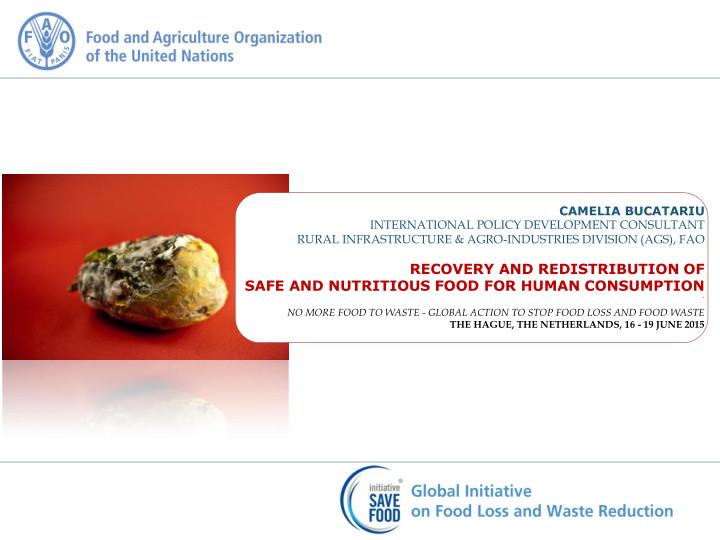



CAMELIA BUCATARIU INTERNATIONAL POLICY DEVELOPMENT CONSULTANT RURAL INFRASTRUCTURE & AGRO-INDUSTRIES DIVISION (AGS), FAO RECOVERY AND REDISTRIBUTION OF SAFE AND NUTRITIOUS FOOD FOR HUMAN CONSUMPTION ` NO MORE FOOD TO WASTE - GLOBAL ACTION TO STOP FOOD LOSS AND FOOD WASTE THE HAGUE, THE NETHERLANDS, 16 - 19 JUNE 2015
GLOBAL SETTING FOOD AND NUTRITION SECURITY SUSTAINABLE NATURAL RESOURCES UTILIZATION ZERO HUNGER CHALLENGE COMMITTEE OF WORLD FOOD SECURITY SUSTAINABLE DEVELOPMENT GOALS, POST – 2015 RECOVERY AND REDISTRIBUTION OF SAFE AND NUTRITIOUS FOOD FOR HUMAN CONSUMPTION TERMINOLOGY FIGURES AND FACTS
NOTE: DATA FOR 2014 – 16 REFER TO PROVISIONAL ESTIMATES SOURCE: FAO. 2015. THE STATE OF FOOD INSECURITY IN THE WORLD 2015
SOURCE: FAO. 2013. FOOD LOSSES AND WASTE FOOTPRINT: IMPACT ON NATURAL RESOURCES
2012 Rio+20 a vision to unite all FLW co-chairs: FAO, UNEP, UNIDO close collaboration: IFAD, WFP interconnectedness of worlds’ food system and impacts on poverty, hunger, malnutrition, natural resources and climate Post-2015 Sustainable Development Goals (SDGs) Goal No. 12.3 Sustainable Consumption and Production United Nations Summit to adopt the post-2015 development agenda 25 Sep 2015 - 27 Sep 2015, New York, USA
FLW CAUSES consequences of how food systems function → technical, cultural, economic → require an integrated & interrelated perspective → feasible and sustainable solutions → prioritize actions macro-level → meso-level → micro-level FLW SYSTEMIC RECOMMENDATIONS States and international organizations: integrate system perspective in food security and nutrition Reduction of FLW → improve agricultural and food systems efficiency and sustainability → improved food security and nutrition Four parallel and inclusive supportive tracks: 1. Improve data collection and knowledge sharing on FLW 2. Develop effective strategies to reduce FLW, at the appropriate levels 3. Take effective steps to reduce FLW 4. Improve coordination of policies and strategies in order to reduce FLW
Assessment Evidence-based Awareness/capacity methodology policies development levels strategies Global Community of causes programmes Practice (CoP) impacts investments Coordination and collaboration with public and private sector, academia, civil society, IFAD, WFP, UNEP, UNIDO FAO multi-disciplinary working group (HQ & Sub/Regional/ National/Liaison Offices) Beneficiaries: the global agricultural and food system stakeholders Primary production Post-harvest handling Processing Distribution Sales Consumption By – products and waste management optimization
Across supply chains in industrialized, emerging Spilled/spoilt/lost mass or volume & developing countries Incurs reduction in quality Food losses and in international (e.g. macro-µnutrients) supply chains Unintended result of processes / institutional / legal frameworks Food loss qualitative & quantitative Discarded mass or volume Fit for human consumption (from primary production to fork) Food waste Results from negligence or conscious decision
Recovery and Redistribution of safe and nutritious food for human consumption Voluntary Definitional Framework, 2015 Recovery of safe and nutritious food for human consumption receive, with or without payment, food (processed, semi-processed or raw) which would otherwise be discarded or wasted from the agricultural, livestock and fisheries supply chains of the food system. Redistribution of safe and nutritious food for human consumption store or process and then distribute the received food pursuant to appropriate safety, quality and regulatory frameworks directly or through intermediaries, with or without payment, to those having access to it for food intake. Current implementation models high variety of stakeholders gleaning networks, food banks (warehouse, direct service, virtual, mixed form), social supermarkets / community shops, food pantries, soup kitchens, community/charitable programmes, shelters, mixed form of social protection programmes that provides food, directly or indirectly, among other services Opportunity: identify policy critical points for intervention in the food supply chains, public – private and civil society partnerships, addressing the social gaps SOURCE: HTTP://WWW.FAO.ORG/SAVE-FOOD
Paper (forthcoming) on Recovery and redistribution of safe and nutrition food for human consumption and food waste prevention and reduction. FAO. 2015. Knowledge and Information for Sustainable Food Systems Survey sourced data: 44 countries in 2013 and 2014 FEBA and food banks in GFN FIGURE 1. RECOVERY AND REDISTRIBUTION OF SAFE AND NUTRITIOUS FOOD FOR HUMAN CONSUMPTION AND FOOD WASTE PREVENTION AND REDUCTION – CONCEPTUAL FRAMEWORK (VERSION 1.0). SOURCE: AUTHOR
Paper (forthcoming) on Recovery and redistribution of safe and nutrition food for human consumption and food waste prevention and reduction. FAO. 2015. Knowledge and Information for Sustainable Food Systems Relevant identified areas: number of people assisted (societal dimension) institutional/policy/regulatory frameworks multiple options for operational implementation challenges: public – private – civil society partnerships; implementation capacity to address an increasing social demand; tools for monitoring and evaluation, including food safety , quality and human nutrition; monitoring and evaluation, accountability.
JOIN SAVE FOOD
Recommend
More recommend